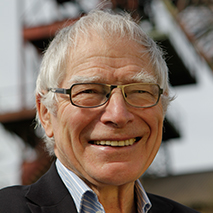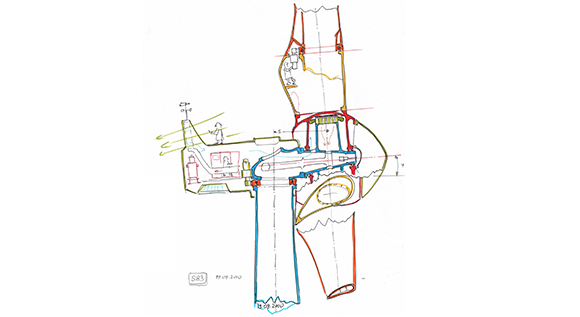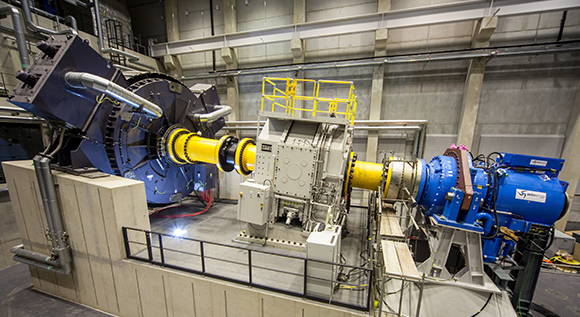Wind-power installations with a gearbox or without: two different systems that are dividing opinion
For a number of years now, two fundamentally different methods of constructing wind-power installations have stood side by side: wind-power installations with an integrated gearbox, and wind-power installations without. What are the technical advantages of each system? Which technology is more forward-looking? Professor Friedrich Klinger (University of Applied Sciences of the Saarland) and Professor Georg Jacobs (University of Applied Sciences of Aachen) have differing opinions on the matter.
Background
Wind-power installations with an integrated gearbox are as readily available on the market as those without. Both are continuously being developed in terms of their capacity, their reliability, and their lifespan. At the same time, each are based on fundamentally different technologies. Professor Friedrich Klinger is a pioneer of wind-power installations without a gearbox. He and his wind energy research group – today based at the University of Applied Sciences of the Saarland – have been working on this type of installation since 1990. In contrast, Professor Georg Jacobs, Director of the Institute for Machine Elements and Machine Design at the University of Applied Sciences in Aachen, focuses his research on further developing wind-power installations with a gearbox. We interviewed both experts, each of which was keen to highlight the special advantages of their particular system. Only time will tell which technology will go on to lead the way in the future.
CHAMPIONING A GEARLESS SYSTEM: PROF. FRIEDRICH KLINGER
 © A.J. Schmidt
© A.J. Schmidt
Professor Klinger, what, in your opinion, are the technical advantages of wind-power installations without a gearbox?
Klinger: The advantage is that the rotary energy is transferred directly to the generator, hence the name "direct drive" that we give to this system. There is no gearbox needed between the rotor and the generator. This makes the drive train – well, up to the static converter at least – almost maintenance-free. Without a gearbox, the system is more robust, the layout more simple, and the number of parts needed reduced by over half. Even when working with partial loads at the smaller end of the scale – i.e. up to 30 per cent of the nominal capacity – the power transmission efficiency is considerably greater. This is also linked to the fact that the synchronous generator used in this system works using permanent magnets, which means no power is lost, as is the case with systems that use electromagnets. Our institute has proposed that this type of generator be used first of all in wind-power installations, with the rotor to be placed externally. This means that the generator will have a smaller external diameter.
Will we see this type of drive train technology establish itself on the market in the next 10 to 20 years?
Klinger: As availability and maintenance costs for the large megawatt machines will become an increasingly important factor in the cost of generating electricity, direct drives will become the number-one choice for wind-power installations in the long-term – for the most part, at least. When we take the case of the bicycle dynamo used for lighting for example, which is now a mass market product, we see that it took decades for the friction drive to be replaced by the hub dynamo, which is driven directly.
 Sketch of a wind-powered installation without a gearbox penned by Prof. Friedrich Klinger © INNOWIND Forschungsgesellschaft mbH
Sketch of a wind-powered installation without a gearbox penned by Prof. Friedrich Klinger © INNOWIND Forschungsgesellschaft mbH
In what ways can this system be further developed?
Klinger: There are proposals for fitting the generator with superconducting coils in order to reduce its size. However, developing and producing a generator of this kind might be too expensive. A purely hydrostatic drive train has been developed and built by Artemis Intelligent Power Ltd. and Mitsubishi Hitachi Power Systems Ltd. Instead of using gears and converters, this drive train works using hydraulic oil pumps and motors which enable a variable transmission speed. We are developing a hub generator, which is a gearless drive train of the next generation. We are trying to integrate the generator into the hub or to attach the rotor blades directly to the outrunner of the generator in order to save on weight and connecting flanges.
CHAMPIONING WIND-POWER INSTALLATIONS WITH A GEARBOX: PROF. GEORG JACOBS
Professor Jacobs, what, in your opinion, are the technical advantages of wind-power installations with a gearbox?
Jacobs: The rotor used in a wind-power installation harvests around 50 per cent of the wind’s air flow rate and converts this into mechanical energy, before this is then converted into electrical energy using a generator. The size of generator that is needed is primarily dependent on its torque. The lower the torque, the larger the generator, and the more copper and magnetic material needed, which causes manufacturing costs to rise. Gearboxes allow for higher rotor speeds meaning that the size of the generator can be considerably reduced. For a modern onshore 2.5 MW wind-powered installation, this means that the rotational speed of approx. 14 rotations per minute (rpm) is converted into a generator speed of 500 to 1,650 rotations per minute. Gearboxes are used in a wide range of applications in industrial drive technology, because they help reduce the size of generators, pumps, and electric and hydraulic motors, and bring down costs. The same is happening in the automotive industry, where manufacturers combine electric motors that have a high torque with mechanical transmission systems to lower the cost of the technology. Now that manufacturers of onshore wind-powered installations, in particular, are faced with stronger international competition, they are increasingly looking to transfer technologies that have led to cost-savings in other industries to their own products.
In what ways can this system be further developed?
Jacobs: The development I have described will depend on the transmission systems used in wind-powered installations becoming even more reliable. And nowadays this mainly depends on the bearings – not only those within the gearbox, but also the main bearing of the rotor. If we want to see progress on this, we need to take into account the exact situation in which these bearings are used – including the loads that come into play here – as we develop and test the next generation of rolling bearings.
Will we see this type of drive train technology establish itself on the market in the next 10 to 20 years?
Jacobs: Yes, we will, because the reliability of this technology will doubtlessly be able to be improved.
 System test bench for 4 megawatt wind turbines at the RWTH Aachen. © Institut für Maschinenelemente und Maschinengestaltung, RWTH Aachen
System test bench for 4 megawatt wind turbines at the RWTH Aachen. © Institut für Maschinenelemente und Maschinengestaltung, RWTH Aachen
These interview snippets have been taken from the Federal Ministry for Economic Affairs and Energy 2014 annual report on research activities (entitled "Innovation through research") which provides an overview of the allocation of research funding in the areas of renewable energy and energy efficiency, as well as a summary of each of the projects supported.

